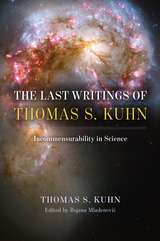134 books about Conservation and 4
start with D
134 books about Conservation and 4
134 books about Conservation
4 start with D start with D
4 start with D start with D
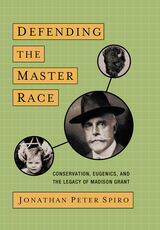
Defending the Master Race
Conservation, Eugenics, and the Legacy of Madison Grant
Jonathan Spiro
University Press of New England, 2008
Scholars have labeled Madison Grant everything from the “nation’s most influential racist” to the “greatest conservationist that ever lived.” His life illuminates early twentieth-century America as it was heading toward the American Century, and his legacy is still very much with us today, from the speeches of immigrant-bashing politicians to the international efforts to arrest climate change. This insightful biography shows how Grant worked side-by-side with figures such as Theodore Roosevelt to found the Bronx Zoo, preserve the California redwoods, and save the American bison from extinction. But Grant was also the leader of the eugenics movement in the United States. He popularized the infamous notions that the blond-haired, blue-eyed Nordics were the “master race” and that the state should eliminate members of inferior races who were of no value to the community. Grant’s behind-the-scenes machinations convinced Congress to enact the immigration restriction legislation of the 1920s, and his influence led many states to ban interracial marriage and sterilize thousands of “unworthy” citizens. Although most of the relevant archival materials on Madison Grant have mysteriously disappeared over the decades, Jonathan Spiro has devoted many years to reconstructing the hitherto concealed events of Grant’s life. His astonishing feat of detective work reveals how the founder of the Bronx Zoo wound up writing the book that Adolf Hitler declared was his “bible.”
[more]
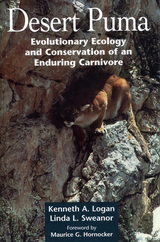
Desert Puma
Evolutionary Ecology And Conservation Of An Enduring Carnivore
Kenneth A. Logan and Linda L. Sweanor; Foreword by Maurice G. Hornocker
Island Press, 2001
Scientists and conservationists are beginning to understand the importance of top carnivores to the health and integrity of fully functioning ecosystems. As burgeoning human populations continue to impinge on natural landscapes, the need for understanding carnivore populations and how we affect them is becoming increasingly acute.Desert Puma represents one of the most detailed assessments ever produced of the biology and ecology of a top carnivore. The husband-and-wife team of Kenneth Logan and Linda Sweanor set forth extensive data gathered from their ten-year field study of pumas in the Chihuahua Desert of New Mexico, also drawing on other reliable scientific data gathered throughout the puma's geographic range. Chapters examine: the evolutionary and modern history of pumas, their taxonomy, and physical description a detailed description and history of the study area in the Chihuahua Desert field techniques that were used in the research puma population dynamics and life history strategies the implications of puma behavior and social organization the relationships of pumas and their preyThe authors provide important new information about both the biology of pumas and their evolutionary ecology -- not only what pumas do, but why they do it. Logan and Sweanor explain how an understanding of puma evolutionary ecology can, and must, inform long-term conservation strategies. They end the book with their ideas regarding strategies for puma management and conservation, along with a consideration of the future of pumas and humans. Desert Puma makes a significant and original contribution to the science not only of pumas in desert ecosystems but of the role of top predators in all environments. It is an essential contribution to the bookshelf of any wildlife biologist or conservationist involved in large-scale land management or wildlife management.
[more]
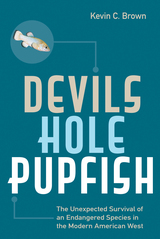
Devils Hole Pupfish
The Unexpected Survival of an Endangered Species in the Modern American West
Kevin C. Brown
University of Nevada Press, 2021
The Devils Hole pupfish is one of the rarest vertebrate animals on the planet; its only natural habitat is a ten-by-sixty-foot pool near Death Valley, on the Nevada—California border. Isolation in Devils Hole made the fish different from its close genetic relatives, but as Devils Hole Pupfish explores, what has made the species a survivor is its many surprising connections to the people who have studied, ignored, protested or protected it.
[more]
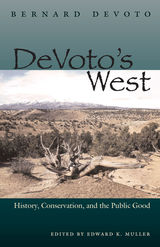
DeVoto’s West
History, Conservation, and the Public Good
Bernard DeVoto
Ohio University Press, 2005
Social commentator and preeminent Western historian Bernard DeVoto vigorously defended public lands in the West against commercial interests. At his death in 1955, DeVoto had won both the Pulitzer and Bancroft prizes. But he was most famous for his eloquent writing that advocated conservation of America's prairies, rangeland, forests, mountains, canyons, and deserts.DeVoto's West: Essays on History, Conservation, and the Public Good showcases the complexity, depth, and breadth of DeVoto's thinking. Editor Edward K. Muller introduces these twenty-two essays (many of which originally appeared in Harper's renowned column The Easy Chair) that passionately and coherently advocate federal control for vast tracts of public land. DeVoto addressed many issues, including the plundering of resources by absentee eastern corporations, Westerners' conflicted relationship to exploitation, and the degradation of the national parks. He believed that conservation of natural resources in the West required government control of public lands against livestock associations, timber interests, and their congressional allies who plotted the privatization of the national forests and the extraction of resources in the national parks.DeVoto's West collects the best of DeVoto's conservation pieces for the first time. It will introduce a new generation to prose that has retained its relevance and remains a remarkably current and timely argument for protecting public lands. Bernard DeVoto was born in Ogden, Utah, in 1897. He spent his adult life in the East, first teaching English at Northwestern University, Chicago, then living in New York, and finally settling in Cambridge, Massachusetts. He is the subject of an acclaimed biography, The Uneasy Chair, by Wallace Stegner.
[more]
READERS
Browse our collection.
PUBLISHERS
See BiblioVault's publisher services.
STUDENT SERVICES
Files for college accessibility offices.
UChicago Accessibility Resources
home | accessibility | search | about | contact us
BiblioVault ® 2001 - 2024
The University of Chicago Press



